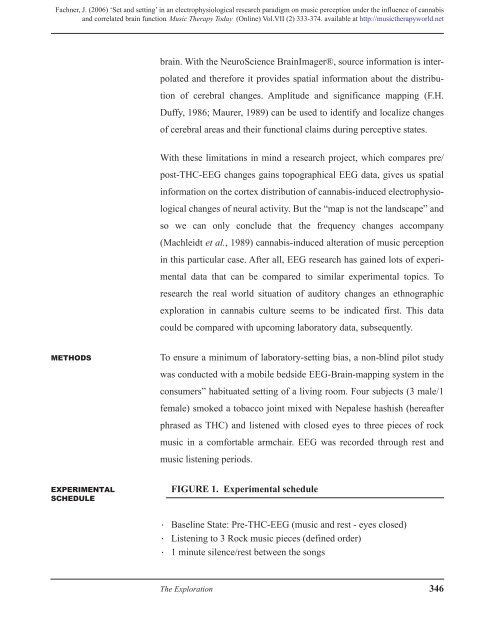Music Therapy Today - World Federation of Music Therapy
Music Therapy Today - World Federation of Music Therapy
Music Therapy Today - World Federation of Music Therapy
You also want an ePaper? Increase the reach of your titles
YUMPU automatically turns print PDFs into web optimized ePapers that Google loves.
Fachner, J. (2006) ‘Set and setting’ in an electrophysiological research paradigm on music perception under the influence <strong>of</strong> cannabis<br />
and correlated brain function. <strong>Music</strong> <strong>Therapy</strong> <strong>Today</strong> (Online) Vol.VII (2) 333-374. available at http://musictherapyworld.net<br />
brain. With the NeuroScience BrainImager®, source information is inter-<br />
polated and therefore it provides spatial information about the distribu-<br />
tion <strong>of</strong> cerebral changes. Amplitude and significance mapping (F.H.<br />
Duffy, 1986; Maurer, 1989) can be used to identify and localize changes<br />
<strong>of</strong> cerebral areas and their functional claims during perceptive states.<br />
With these limitations in mind a research project, which compares pre/<br />
post-THC-EEG changes gains topographical EEG data, gives us spatial<br />
information on the cortex distribution <strong>of</strong> cannabis-induced electrophysio-<br />
logical changes <strong>of</strong> neural activity. But the “map is not the landscape” and<br />
so we can only conclude that the frequency changes accompany<br />
(Machleidt et al., 1989) cannabis-induced alteration <strong>of</strong> music perception<br />
in this particular case. After all, EEG research has gained lots <strong>of</strong> experi-<br />
mental data that can be compared to similar experimental topics. To<br />
research the real world situation <strong>of</strong> auditory changes an ethnographic<br />
exploration in cannabis culture seems to be indicated first. This data<br />
could be compared with upcoming laboratory data, subsequently.<br />
METHODS To ensure a minimum <strong>of</strong> laboratory-setting bias, a non-blind pilot study<br />
EXPERIMENTAL<br />
SCHEDULE<br />
was conducted with a mobile bedside EEG-Brain-mapping system in the<br />
consumers” habituated setting <strong>of</strong> a living room. Four subjects (3 male/1<br />
female) smoked a tobacco joint mixed with Nepalese hashish (hereafter<br />
phrased as THC) and listened with closed eyes to three pieces <strong>of</strong> rock<br />
music in a comfortable armchair. EEG was recorded through rest and<br />
music listening periods.<br />
FIGURE 1. Experimental schedule<br />
• Baseline State: Pre-THC-EEG (music and rest - eyes closed)<br />
• Listening to 3 Rock music pieces (defined order)<br />
• 1 minute silence/rest between the songs<br />
The Exploration 346

















